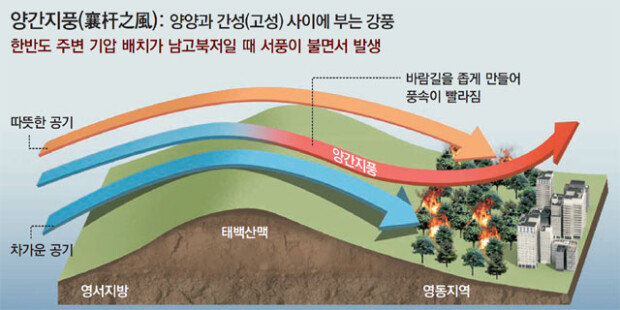Strong winds fan flames in Gangwon Province
Strong winds fan flames in Gangwon Province
Posted April. 06, 2019 08:42,
Updated April. 06, 2019 08:42

A giant forest fire that swept across the Gangwon Province was fanned by strong winds and dry conditions to quickly spread through neighboring cities. In particular, strong regional winds between Yangyang and Goseong are thought to have exacerbated the fires. This was also the case when a huge fire broke out in five cities including Goseong in May 2000, and a forest fire in Yangyang engulfed Naksan Temple in April 2004.
The regional winds are created for three reasons. First, the position of atmospheric pressure. In spring, high atmospheric pressure settles in the southern side of the country, while the northern part comes to be under low atmospheric pressure. Winds blow clockwise around high pressure, and counter-clockwise around low pressure. These opposing winds interact to make strong westerly winds.
The second reason is the Taebaek Mountains. Winds get stronger when they go eastward and descend across the mountain range, and also become speedier as affected by warm air over the ridge. The air remains warm even at night when temperatures on the ground begin to drop, preventing winds from ascending. Therefore, winds get faster while moving along the narrow paths.
Also, the winds in the Misiryeong Valley between Inje and Goseong blew at speeds of up to 31.2 meters per second as of 4:30 a.m. Friday. The speed went up to 35.6 meters per second the previous day. According to the Korea Meteorological Administration, winds blowing at over 17 meters per second are defined as a typhoon. This shows how strong the winds were in the cities affected by the flames. When a huge blaze broke out in northern San Francisco in last November, strong winds with the speed of 22 to 30 meters per second fanned the fires to burn 62,053 hectares.
Fortunately, the winds are apparently growing weaker from Friday afternoon. A gale warning issued for the Yeongdong region in Gangwon Province (declared when winds of over 21 meters per second are expected) has been downgraded to an advisory (declared when winds of over 14 meters per second are in store) since noon. As of 3:00 p.m., the winds were blowing at 18.1 meters per second in Misiryeong, 10.7 meters in Gangneung, 10 meters in Goseong, 7.5 meters in Sokcho, and 6.7 meters in Donghae.
While large fires have been contained in the Yeongdong region, it is early to let out a sigh of relief. A dry air warning has been in effect since Wednesday in the Yeongdong region, North Gyeongsang Province, and Daegu. The warning is issued when effective humidity levels are below 25 percent. The levels are calculated based on the average humidity of the past five days and the dryness of fiber in plants such as trees. The lower these levels are, the more likely fire will break out.
In addition, a gust of wind created by local winds needs to be monitored. “Strong winds we’ve seen on Thursday and Friday are currently not in store, but particular attention needs to be paid to a gust of wind that can be made locally in the affected areas,” said Yoon Gi-han, a forecaster at the Korea Meteorological Administration. Just like water drops bound back on the ground when poured down, strong winds descending across the Taebaek Mountains can ascend back, generating irregular winds, he explained.
kej09@donga.com







